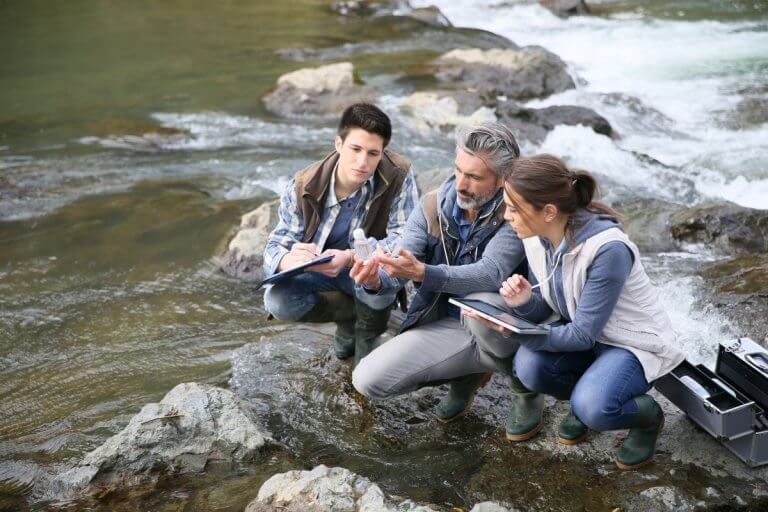
If feels like Earth’s on the brink of environmental collapse. The evidence is everywhere – from the deadly wildfires engulfing California to the sea birds dying on the Norfolk coast, and the floods that damaged 10,000 properties in the UK in 2010.
As we race to stem the damage of climate change and other environmental issues, the collective will of politicians, businesses and the public to co-operate seems somewhat elusive. But you best believe that solutions are not lacking.
Environmental scientists are coming up with ingenious and innovative ways to save our planet; including jets that spray particles into the stratosphere to slow the earth’s warming and machines that mimic trees to suck carbon dioxide (CO2) out of the air. These are today’s true agents of change.
The scientists behind these feats and the universities that support them are bastions of hope for us all. Current students of environmental science will follow in their footsteps, labelled the “last generation that can put an end to climate change” by former secretary general for the United Nations, Ban Ki-Moon.
Environmental science, the multi-disciplinary branch of STEM that focuses on the physical environment and the solution of environmental problems, is now at the frontline of higher education’s duty and opportunity to create a more sustainable future for all.

University of York
While some world leaders continue to deny the effects of climate change, universities have established the University Climate Change Coalition to commit their research and resources to “help communities accelerate climate action”, reducing carbon footprints while bringing business and political leaders together at a forum on best practices in these pursuits.
The Climate Leadership Network is another example of higher education leveraging institutional strength, showing that a commitment to climate action through research and action is possible and should be done.
Join these honourable UK environmental science schools on their noble quests to environmental stability:
COLLEGE OF ENVIRONMENTAL SCIENCES AND ENGINEERING, BANGOR UNIVERSITY
There are many reasons why the College of Environmental Sciences and Engineering at Bangor is one of the UK’s leading research and teaching centres.
With three interconnected academic schools – School of Computer Science and Electronic Engineering, School of Natural Sciences, School of Ocean Sciences – the College spans a diverse range of concentrations, as well as research and teaching facilities.
From a £3.5 million sea-going research vessel, to a Natural History Museum with extensive invertebrate and vertebrate collections, to several research centres; students here have all the support they need to accelerate their pursuit of knowledge and solutions.
A wide range of programmes are offered, including undergraduate, taught postgraduate degrees, MRes programmes and a formally-structured research programme. You’ll be pleased to know that they’re top-ranking, too.
The Environmental Science programme is rated Gold for Teaching Quality in the Teaching Excellence Framework (TEF 2017), ranked top 30 in the UK (Times/Sunday Times Good University Guide 2018) and has a 100 percent Student Satisfaction rate in 2017 National Student Survey (NSS).
With these awards and a world-class research-led environment, the College is showing what leadership in educating and training a new generation of socially-aware, bright scientists is about.

Bangor University
DEPARTMENT OF ENVIRONMENT AND GEOGRAPHY, UNIVERSITY OF YORK
What began in 1992 as a research and training programme in environmental economics and environmental management, has since developed into exciting and dynamic centres in the field today.
The Department may be based in North Yorkshire, England, but its world-leading research covers topics of environmental importance all over the globe. Crossing disciplines is typical of research here, whether it’s across the natural and social sciences or the merging of atmospheric chemistry, environmental economics and policy analysis.
Staff boast experience on international and national committees, a recognition of the Department’s work at the highest level.
“Our staff are experts in a wide range of environmental and geographical disciplines and we are all committed to delivering a first-rate student experience,” said Professor Mark Hodson, Head of Department.
With strong links to global policy makers such as the United Nations Environment Programme and the World Health Organisation and key partnerships with major environmental organisations, students here benefit from the abundant expertise and research and internship opportunities available.

University of York
SCHOOL OF NATURAL AND BUILT ENVIRONMENT, QUEEN’S UNIVERSITY BELFAST
Intense. Enthusiastic. Positive. That’s how Professor Greg Keeffe, Head of School describes the newest school in Queen’s and he’s right.
By uniting well-established disciplines of Architecture, Civil & Structural Engineering, Geography, Planning, Archaeology & Palaeoecology, the School is ready to study and research the challenges and opportunities in the natural and built environment.
For students, expect an educational journey that is “built on rigorous interdisciplinary teams, acute analysis, in-depth reasoning and creative thinking”. After all, this is a school with an outstanding reputation for teaching and research – it is ranked within the top 100 globally for Archaeology and within the top 200 for Geography (QS World University Rankings 2018).
Research here has its own specialised teams and facilities. The Geographical Information Science (GIS) Unit is complemented by the Map Library, which houses an extensive collection of maps belonging both to the University and the School. To understand environmental change, a specialised research cluster focuses on how the Earth’s environments have changed, or are changing, over a range of different time scales from 50k years to the near instantaneous.
From studying the changing Earth’s environment to tackling some of the world’s most pressing urban challenges, the School is where groundbreaking research is making a global impact.

Queen’s University Belfast
FACULTY OF NATURAL SCIENCES, UNIVERSITY OF STIRLING
The Faculty of Natural Sciences at the University of Stirling has one goal: inspiring students to be the difference they want to see in the world. Employing a philosophy that puts flexibility, practical training and student satisfaction at the heart, the faculty is well-poised to meet this need.
Many undergraduate and postgraduate offerings are accredited by leading industry bodies.
Beyond committed teaching, there’s a passion and curiosity embedded within each and every course – that’s why it’s been named first in Scotland for having good teachers, quality lecturers and performance feedback in the most recent International Student Barometer, also ranking joint eighth in the UK for high-quality staff and lecturers.
Alumni echo this sentiment. MSc Environmental Management graduate Fraser Bell, who has been working with Wind Prospect as a Development Officer working on large-scale wind farm projects UK-wide, credits Stirling for giving him the tools and skills needed to progress his career.
“This course has given me a fantastic opportunity and a great start to my career, and I would recommend anyone to apply for this course if they would like to pursue a career in renewable energy,” he said.
*Some of the institutions featured in this article are commercial partners of Study International
Liked this? Then you’ll love…
World-changers welcome: Create the digital future
4 schools that support global sustainability and environmental entrepreneurship







